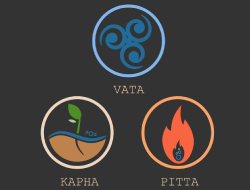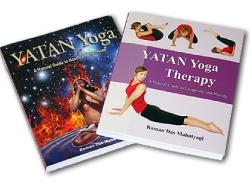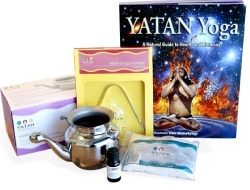Magazine and Newspaper Reviews for Yatan Yoga
Yatan Yoga – A Natural Guide to Health and Harmony and Yatan Yoga Therapy – A Natural Guide to Longevity and Vitality are Vaidya and Yogi Raman Das Mahatyagi’s large format full colour books on his approach to Yoga, integrating Ayurveda, Tantra and Astrology.
Both books are suitable as guides for yoga for beginners, with most asana poses having easier versions to start your practice with.
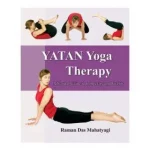
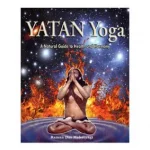
For further insight please read the following book reviews from Australian Health Magazines and bookstores.
Nova Magazine – July 2008
(Reviewed by Chandrika Gibson)
This glossy, colourful tome is the culmination of 38 years of yoga practice and a lifetime of Ayurvedic healing by the esteemed Mahatyagi (great yogi) Raman Das. Based in Sydney since 2000, Raman Das has a loyal following and receives rave reviews from his regular clientele. The capitalised title YATAN stands for Yoga, Ayurveda, Tantra, Astrology and Natural Therapies. By utilising all the wisdom of these different specialty areas, the author expounds a completely holistic lifestyle.
Raman Das grew up in India and was influenced by his father and grandfather who both practiced Ayurveda and had an interest in yoga. The young aspiring yogi sought out acharyas (teachers) and later pursued a scientific understanding of the body at university. His interest in the Vedic healing traditions encompasses palmistry, astrology, face reading, mantra, tantra, yogic cleansing, asanas, Ayurveda, dietary guidelines and spiritual meditation.
Having established a successful international Ayurvedic clinic in Nepal, and lived for some time in his own ashram in Varanasi, India, Raman Das now sees clients and teaches yoga at his Sydney centre. He is a member of a number of Australian natural therapy bodies, as well as Ayurvedic associations and the Yoga Teacher’s Association of Australia.
The product of 12 years’ writing, YATAN Yoga is an excellent resource book for those with a new or developing interest in all things yogic and Indian. Yet it also holds gems for experienced yoga practitioners. The sections on Tantra, Ayurveda and Astrology are relatively concise, but what is unique is how Raman Das ties yoga asana practice to the other disciplines. For example, he gives detailed charts of how the doshas (Vata, Pitta, Kapha) can be increased, decreased or balanced by various asanas.
Sceptics may struggle with the matter of fact explanations of how karma operates and the effect of the planets on individuals, but many yogis and wise people in the past and present hold similar views. There is no attempt made to back this philosophical standpoint up with any hard science which makes for light and easy reading. The author does acknowledge this area is not appealing to everyone and suggests skipping the astrology section if it is not suited to your temperament or stage of development.
The asanas section features wonderful photographs of a yogini and Raman Das performing the postures. The explanations are quite simple and clear enough to be followed by a relatively inexperienced reader. Most of the featured asanas are accessible as for beginners, although some more challenging poses are included. Each asana has listed benefits and detailed stage by stage illustrations.
A total holistic yoga lifestyle is emphasised with detailed dietary recommendations, and a section on basic pranayama, mantra and meditation. This book covers the yogic spectrum very thoroughly. Suitable for yoga teachers, therapists, students and lay people alike, it is very appealing in its layout and enlightening in its content. This all makes for an essential guide for yoga at home also.
The accumulated wisdom and wealth of experience of the author shine through, making this a truly illuminating reading experience which entices the senses, yet stimulates the desire for a deep spiritual practice.
Nature and Health April-May 2008
An informative and practical guide that embraces classical and scientific perspectives, blending the Vedic sciences of yoga, Ayurveda, Tantra and astrology with a modern understanding of physiology.
Living Now – March 2008
(Reviewed by Sue Sammartino)
Raman Das Mahatyagi has produced the ultimate text for yoga enthusiasts in his yoga book.
The opening chapters contain all the information an aspiring yogi could need to understand and implement an effective practice for yoga at home, as well as enlighten long time practitioners lacking in the fundamentals of yoga as a result of poor initiation.
These chapters cover definitions of the various types of yoga and their application to a yogi’s lifestyle, as well as meditation and pranayama styles.
Raman Das Mahatyagi has used questionnaires and charts to help the reader define their personal needs and relate them to the appropriate yoga practice, drawing on ancient philosophy and tradition. This book also contains a glossary of Sanskrit terms as well as appendices of complementary Ayurvedic products to enhance yoga practice.
The chapters describing the yoga asanas are easy to follow with brief, precise explanations and clear photographs enabling readers to follow their own programs with ease.
Of all the yoga books on my shelf, I have found “YATAN Yoga” the easiest to follow. Readers will find links to other aspects of personal and spiritual evolution, prompting a review of their practices in line with their own needs and a desire to use their new found wisdom.
Adyar Bookstore
Through 38 years of personal yoga practice, the author has developed an understanding of the science involved within yogic practices and how they deeply benefit the body on all energetic levels. This yoga book incorporates his knowledge to present a detailed guide to enhancing and improving the general wellbeing and spiritual health of all levels of yoga practitioners.
The yogic practices have been divided into 4 stages. Each stage is based on the theory of the physiological monitoring system of the body and therefore provides optimum results for the individual. The pattern of breath inhalation, retention and exhalation is also explained, enabling the physiology of the body to be stimulated, pacified or balanced as needed. The benefits, cautions and contraindications are outlined for every posture. The Ayurvedic mind-body constitutional types, otherwise known as doshas – vata, pitta and kapha – are explained in detail and the effect each posture has on the body types is given. Each yoga position is well photographed and illustrated and the instructions are easy to read.
‘YATAN Yoga’ differs from many yoga books in that it also includes information on how the planetary system influences our health and well-being and chapter 3, an essay on Tantric yoga, explains this often misunderstood subject in detail. This is a comprehensive and highly recommended book for yoga practitioners of all levels.
Indian Down Under – August 2009
(Reviewed by Neena Badhwar)

